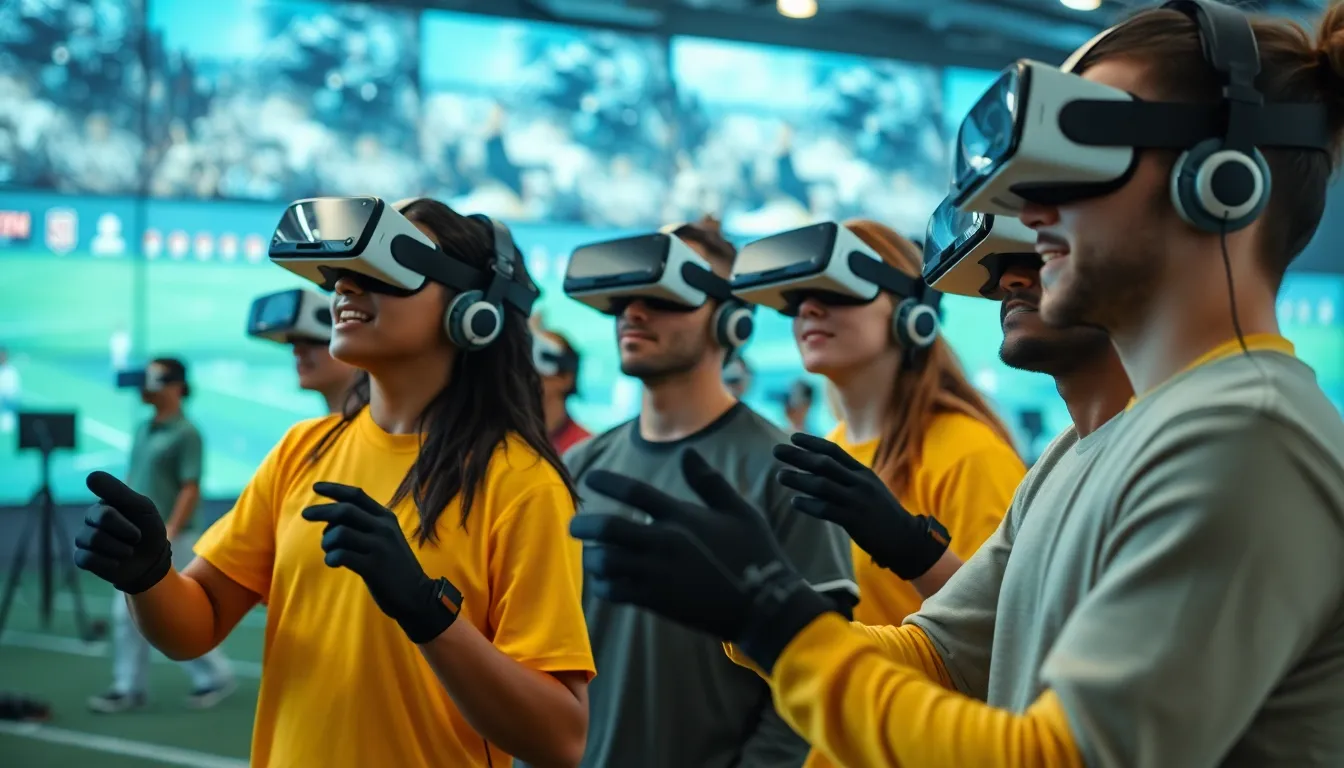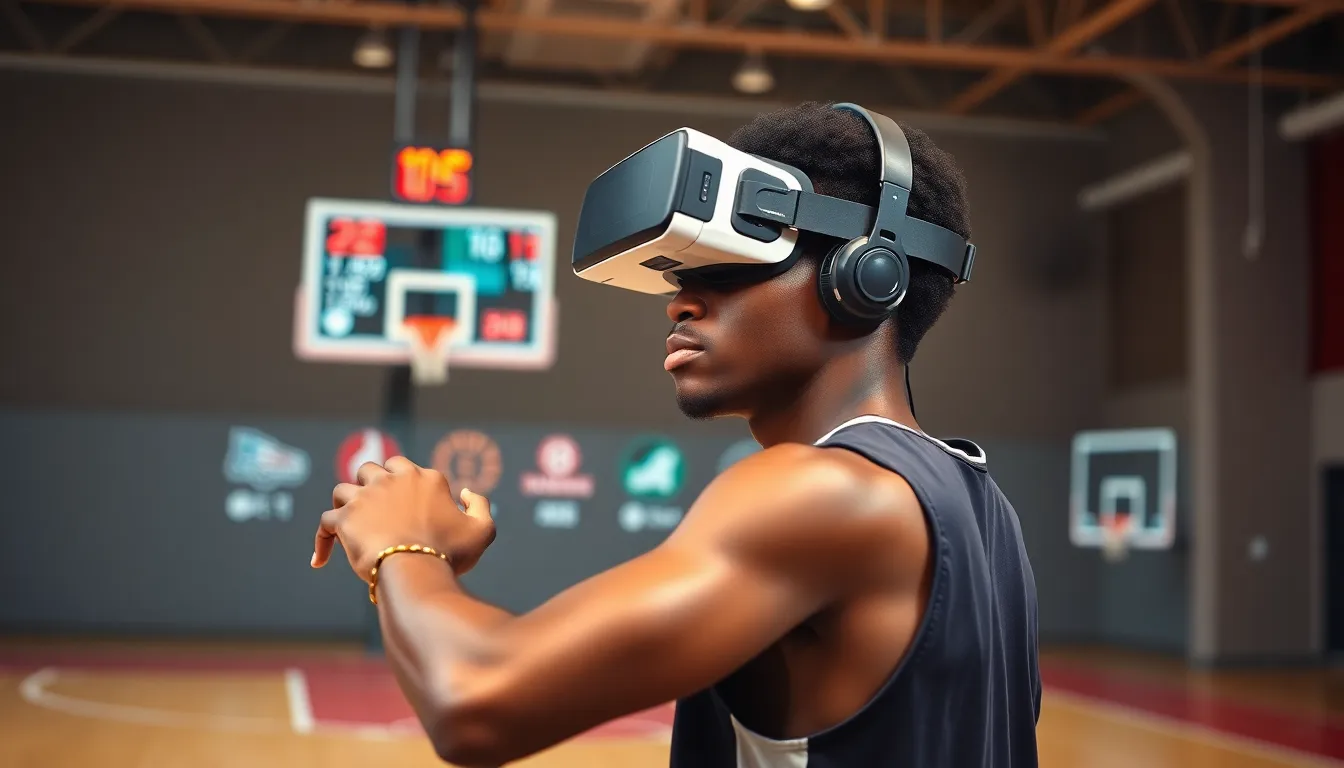Virtual reality is revolutionizing the way athletes train and fans experience sports. Imagine stepping onto the field or court without leaving your living room—it’s not just a dream, it’s the future of sports. With VR, athletes can practice their skills in immersive environments, making training sessions feel like a video game. Who wouldn’t want to dodge tackles or sink three-pointers while wearing a headset?
But it’s not just for the pros. Fans can now cheer from the best seat in the house, even if they’re miles away. Whether it’s feeling the adrenaline of a last-minute goal or celebrating a championship win with friends, VR is bringing everyone closer to the action. So, buckle up and get ready for a wild ride through the world of VR in sports, where the lines between reality and imagination blur, and every game feels like a championship match.
Table of Contents
ToggleOverview of VR in Sports
VR technology is revolutionizing the sports sector, impacting both training techniques and audience engagement. It provides athletes with a dynamic platform to practice skills in realistic scenarios. Training sessions can mimic actual competition settings, enabling athletes to refine strategies and enhance performance metrics.
Moreover, VR facilitates immersive experiences for fans. Live events become accessible from multiple angles, allowing spectators to feel present even when physically distant. Fans can choose their perspective, whether it’s courtside at a basketball game or field-level during a football match.
The integration of VR in fan experiences also extends to interactive content. Some platforms offer virtual meet-and-greets with players or behind-the-scenes looks at teams and their training routines. Enhanced engagement fosters a deeper connection between fans and their teams.
Data from various studies underscores the effectiveness of VR in improving athletic performance. Research reveals that athletes using VR training technologies demonstrate a 30% increase in skill retention when compared to traditional methods. This figure illustrates the potential VR holds for optimizing training efficiency.
Innovations continue to emerge across different sports. Developers explore applications in areas like rehabilitation for injuries, helping athletes recover more effectively. As the technology evolves, the possibilities for its integration into sports continue to expand, transforming not only how athletes train but also how fans experience their favorite teams.
Benefits of VR in Sports

Virtual reality (VR) presents significant advantages for athletes and fans alike. Enhanced training techniques and improved fan engagement exemplify these benefits.
Enhanced Training Techniques
Athletes experience immersive training environments through VR technology. Training sessions become engaging and realistic, allowing for improved skill development. These environments enable athletes to practice under conditions that mimic actual competitions. Research shows athletes using VR demonstrate a 30% increase in skill retention compared to traditional training methods. Additionally, VR allows for personalized feedback, enabling targeted efforts in skill refinement. Coaches can monitor performance metrics in real-time and adjust training regimens accordingly. As a result, athletes gain crucial insights, ultimately leading to better on-field performance.
Improved Fan Engagement
VR transforms how fans engage with sports events. Viewers enjoy access to interactive experiences from multiple vantage points. Whether courtside at a basketball game or field-level during a football match, fans experience excitement that feels real. Various platforms offer virtual meet-and-greets with players and behind-the-scenes access to teams. These innovations create a unique bond between fans and their favorite athletes. Engaging content enhances the thrill of game day, making every event memorable. The level of engagement through VR drives deeper connections, ultimately increasing fan loyalty.
Applications of VR in Sports
Virtual reality (VR) transforms athletic training and fan engagement in sports. It creates immersive experiences that enhance skills and foster connections.
Virtual Training Environments
Athletes utilize VR to practice in lifelike settings that simulate real competition conditions. Enhanced training techniques rise through these immersive environments. Coaches appreciate the real-time performance metrics, allowing for immediate feedback and targeted adjustments. Studies show athletes training with VR demonstrate a 30% improvement in skill retention, compared to traditional methods. This technology helps refine decision-making under pressure, crucial for high-stakes situations. Injury rehabilitation also benefits, as athletes can safely simulate movements needed for recovery.
Fan Experience and Virtual Events
VR revolutionizes the way fans engage with sports events. Spectators enjoy unique perspectives, accessing courtside views at basketball games or field-level positions in football. Many platforms provide interactive elements, such as virtual meet-and-greets with athletes and behind-the-scenes content. By creating an immersive atmosphere, VR enhances the overall thrill of game day. Loyalty from fans rises, as they experience events like never before. Data indicates that this level of engagement fosters lasting connections, increasing fan attachment to teams and athletes.
Challenges and Limitations
VR technologies face significant challenges in sports. These hurdles might hinder broader adoption among athletes and fans.
Cost and Accessibility
Costs associated with VR equipment can be prohibitive. High-quality headsets and software often exceed $1,000, which restricts access for many potential users. Additionally, subscription fees for premium content may discourage engagement. Limited investment in VR infrastructure at sports facilities further complicates accessibility. Not every venue is equipped to support advanced VR systems, limiting fan experiences even in major markets. As such, affordability remains a barrier that prevents widespread use, especially among amateur athletes and smaller teams.
Technological Limitations
Technological constraints also pose challenges to VR in sports. Issues like motion sickness can arise during prolonged use of VR gear. High system requirements often necessitate powerful hardware, which some users might not possess. Furthermore, latency can disrupt the immersive experience, leading to frustration for athletes and fans alike. Quality of graphics depends on the software, with subpar visuals detracting from realism. Ensuring the seamless integration of VR experiences across different devices and platforms proves to be another challenge. These limitations must be addressed to enhance user satisfaction and engagement.
Future of VR in Sports
Innovations in virtual reality continue to reshape the landscape of sports. Training methodologies improve significantly as athletes leverage VR systems to simulate competition scenarios. This technology enhances skill retention by up to 30%, compared to traditional training methods. As a result, athletes gain a competitive edge, refining not just physical skills but also decision-making abilities in high-pressure environments.
Fan engagement experiences also evolve. Virtual reality platforms allow fans to select their viewing angles during live events. They can choose experiences that provide courtside seats at basketball games or field-level views at football matches. Interactive content, including virtual meet-and-greets with athletes, provides a more personal connection between fans and their favorite players.
Several challenges remain, such as high costs of VR equipment, often exceeding $1,000. This financial barrier limits access for amateur athletes and smaller teams. Subscription fees for premium content and insufficient investment in VR infrastructure at venues pose additional obstacles. Moreover, issues like motion sickness and latency hinder overall user experience.
Addressing these challenges becomes crucial for the broader adoption of VR in sports. Continued advancements in technology could lower costs and improve accessibility. Enhanced graphical quality and reduced motion sickness incidences would also transform user satisfaction. Growth in the VR sphere promises more engaging platforms for athletes and fans alike, creating deeper connections. As such, it’s essential for sports organizations to explore innovative solutions that expand the VR realm and its benefits for all stakeholders.
The integration of VR in sports represents a groundbreaking shift that enhances both training and fan engagement. As athletes leverage immersive environments to refine their skills and decision-making, fans enjoy unprecedented access to live events and interactive experiences. This technology bridges the gap between reality and imagination, transforming how sports are experienced.
While challenges like high costs and technological limitations persist, ongoing innovations promise to make VR more accessible. As the sports industry embraces these advancements, the potential for deeper connections between athletes and fans continues to grow. The future of sports with VR is not just promising; it’s poised to redefine the entire landscape of athletic engagement and performance.




